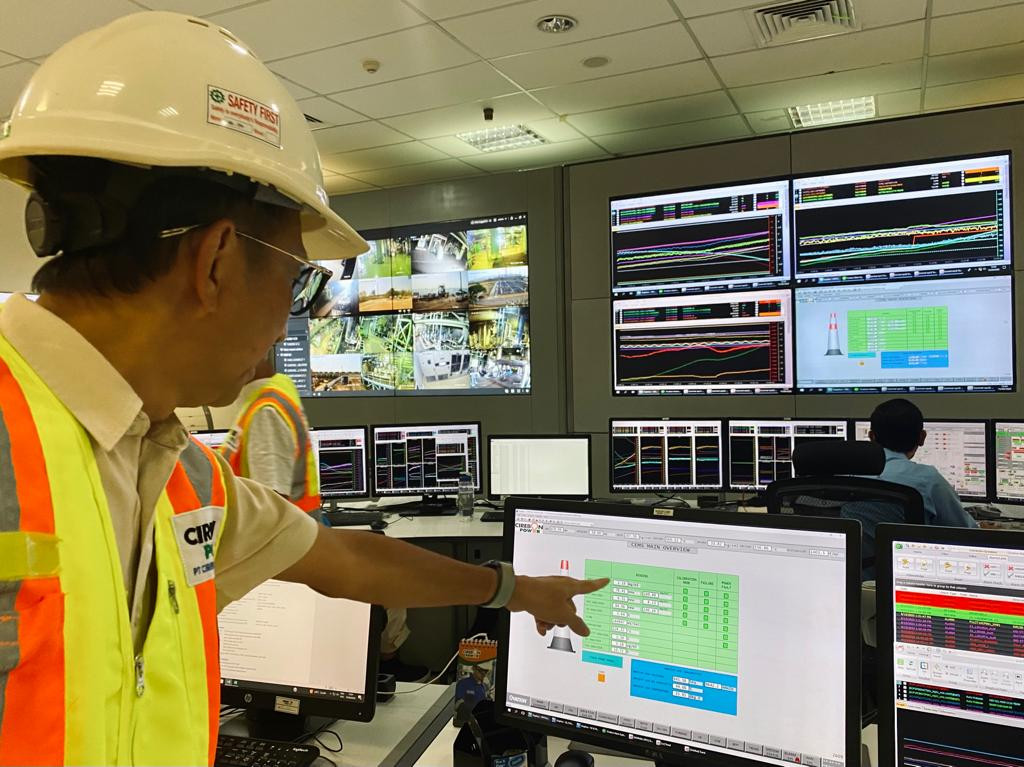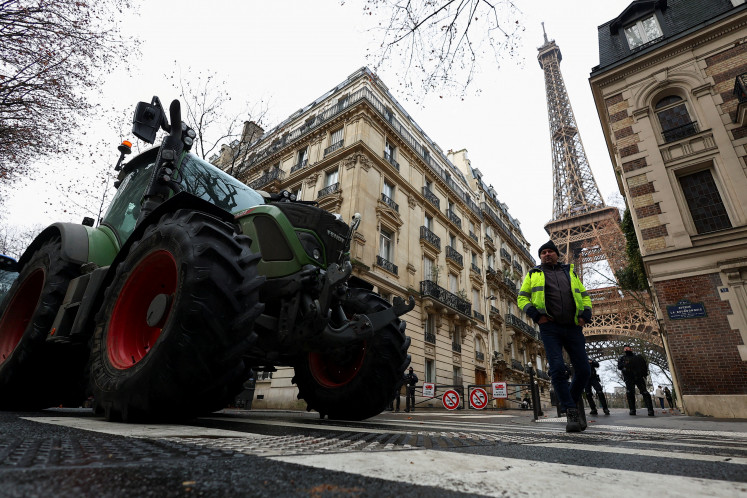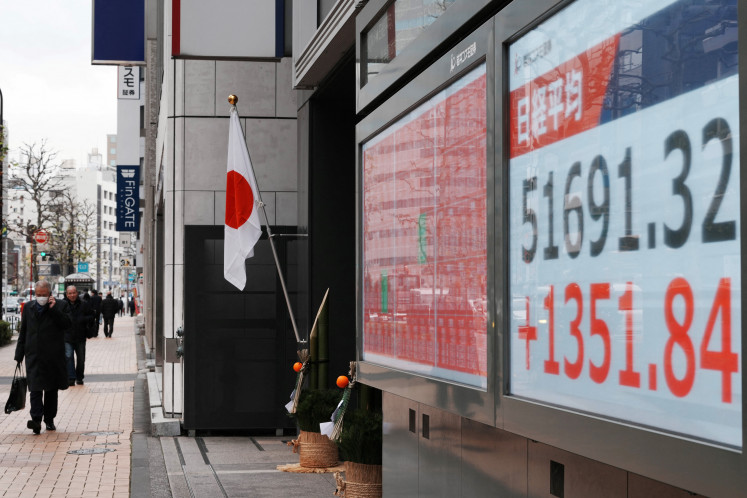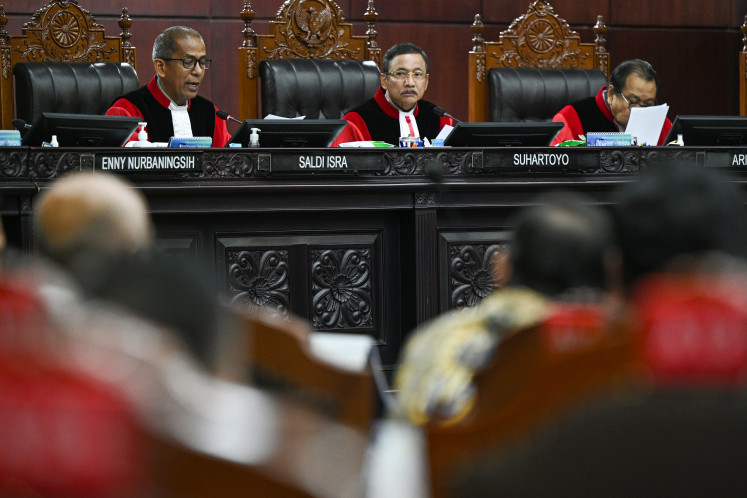Popular Reads
Top Results
Can't find what you're looking for?
View all search resultsPopular Reads
Top Results
Can't find what you're looking for?
View all search resultsCirebon Electric says coal plant emissions comply with quality standards
CEP is an international consortium comprising Japan’s Marubeni Corporation, South Korea’s Korean Midland Power Company and Samtan Company, in collaboration with Indonesian power company PT Indika Energy.
Change text size
Gift Premium Articles
to Anyone
 PT Cirebon Electric Power vice president Joseph Pangalila shows live data recorded by the Continuous Emission Monitoring System (CEMS) from its coal plants from its headquarters in Cirebon, West Java, on September 15, 2023. The data can be monitored by the Environment and Forestry Ministry in real time. (The Jakarta Post/Ruth Dea Juwita)
PT Cirebon Electric Power vice president Joseph Pangalila shows live data recorded by the Continuous Emission Monitoring System (CEMS) from its coal plants from its headquarters in Cirebon, West Java, on September 15, 2023. The data can be monitored by the Environment and Forestry Ministry in real time. (The Jakarta Post/Ruth Dea Juwita)
T
he Cirebon 1 coal plant maintains emissions below prevailing environment quality standards and has consistently been in compliance with both local and international environmental regulations, says operator PT Cirebon Electric Power (CEP).
“The government has not filed any complaints as the ambient air monitoring around the power plant confirms compliance with quality standards for all parameters,” CEP environmental engineer Agik Dwika told The Jakarta Post on Friday during a visit to the coal-powered plant in Cirebon regency, West Java.
“Mercury concentrations remain below the quality standards,” Agik added, amounting to only 0.003 mg/m3, while noting that lead, arsenic and cadmium parameters were not stipulated by local and international quality standards.
CEP vice president Joseph Pangalila emphasized the company’s proactive stance on environmental concerns by the fact that it was the first supercritical coal-fired power plant in the country and being supercritical had been integrated into the plant since its inception back in 2006.
A supercritical coal-fired power plant is different from traditional coal power plants in that the water running through it works as a supercritical fluid, making it 45 percent more efficient for a given power output compared with its predecessors, subcritical plants, according to the World Bank.
In terms of emissions, Joseph pointed out that the supercritical plant emits 900 tonnes of CO2 per megawatt-hour (MWh), compared with a subcritical plant’s 1,200 tonnes of CO2 per MWh.
“Our records show that [emissions] remain below the thresholds,” Joseph argued. “If Cirebon [regency] is not polluted, how could [Cirebon 1] possibly affect Jakarta’s air quality?”
The coal plant operator has denied studies that have linked the coal plant to the capital's poor air quality. A recent study from the Centre for Research on Energy and Clean Air (CREA) that has been published in The Jakarta Post claimed that the Cirebon plant, located about 220 kilometers from Jakarta, is among the coal plants that have contributed to the capital's air pollution.
CEP is an international consortium comprising Japan’s Marubeni Corporation, South Korea’s Korean Midland Power Company and Samtan Company, in collaboration with Indonesian power company PT Indika Energy. The plant is situated in an area overlooking the Java Sea in the port city of Cirebon.
In 2012, the facility commenced operations with its first plant, Cirebon 1, boasting a 660-megawatt capacity.
Agik elaborated that CEP has consistently reported its environmental management and monitoring plans, permit status, as well as providing emissions data recorded by the continuous emission monitoring system (CEMS) to the Environment and Forestry Ministry’s SIMPLE and the Energy Ministry’s APPLE GATRIK, both of which record emissions.
CEMS was installed in the chimney to monitor the chemical composition of emissions, including parameters such as SO2, NO2, CO, CO2 and mercury, as well as total particulate matter, opacity, flow rate and the temperature of the chimney exhaust.
CEP also measures emissions that fall outside the power plant area, he added, as a form of mitigation, and regularly controls them through the Air Quality Monitoring Station (AQMS), which was not mandated by the government.
“Even the AQMS, positioned 13 kilometers away from the plant, records that the emissions remain significantly below the established thresholds,” Agik emphasized.
In 2021, the consortium expanded with the introduction of another coal power plant, Cirebon 2, under PT Cirebon Energi Prasarana, generating 1,000 megawatts. The plant harnesses ultra-supercritical technology, significantly enhanced electricity-production efficiency compared with the preceding supercritical technology, CEP operations manager John Earl Sembel explained.
To maintain low emissions, John outlined the power plant’s various strategies. In addition to the supercritical boiler, the plant boasts closed-loop cooling towers, the first of their kind in the country, ensuring that the seawater and water used by the plant and returned to the sea have a temperature difference of only 1 degree Celsius.
For environmental control and residue management, the company has planted seven layers of Acacia trees, employed windbreakers, sweeper and vacuum trucks, and utilizes dust-suppression methods to capture and contain coal dust.
Fly ash and bottom ash, byproducts of coal combustion, are collected using electrostatic precipitators and stored in a silo before being transported via capsule trucks to a concrete company for use in concrete production.
“No fly ash or bottom ash is stored outdoors,” John emphasized. “All such residues are sent to the cement company.”
Refuting the findings from CREA and think tank Prakarsa published in the Post that have linked Cirebon 1 to various respiratory diseases including tuberculosis, among nearby residents, Agik said that poor air quality was a result of many factors like trash piles in landfills and burning of waste that also affect groundwater quality. He added that outdated boat engines used by some fishermen could also pollute the environment.
“Our monitoring indicates that while air pollution does affect health, it does not originate from our plant," he insisted.










